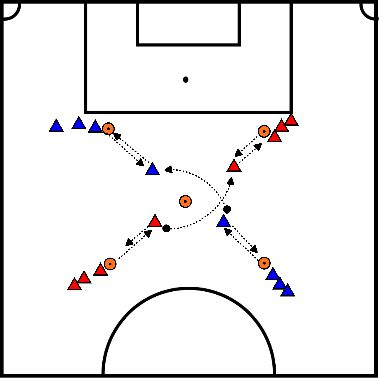Soccer drills for technique warming-up
Exercise begins at the two middle cones.
- S1 passes diagonally to S2.
- S2 rebounds to S3.
- S3 rebounds diagonally to S2 who presents at middle cone.
Exercise then continues on the other side.
6 pots, 2 balls and 6 players.
6 pots, 2 balls and 6 players.
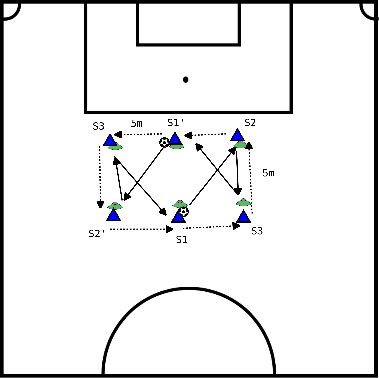
- Make 2 teams.
- Each team stands ready on one side of the field on the back line.
- Put as many balls as players on both the 3-meter lines.
- When the trainer/trainer calls GO!, everyone starts rolling the balls to the other side.
- Whoever has the fewest balls in their field after 3 minutes has won.
- At trainer's signal, both players start sprinting.
- Blue must run around first pawn and Red runs straight through to tap Blue.
- Red becomes Blue and flips over.
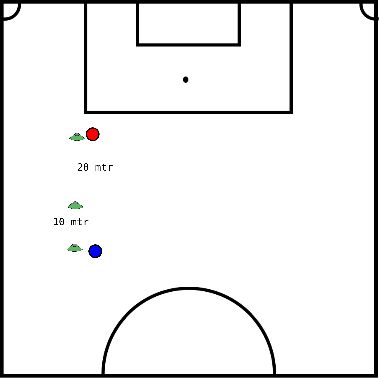
- From hat 1 to 2 jogging.
- From hat 2 to 3 exercises below:
- Tripping forward.
- Tripping sideways.
- Knee lifts forward.
- Knee lifts sideways.
- Heels buttocks forward.
- Heels buttocks sideways.
- Connecting stride.
- Cross stride.
- Hopping.
- Forward slant 3x left 3x right, back away backwards.
- Lunges.
- Frog jumps.
- Sprints 5x back and forth.
- Jogging from hat 4 to 4.
- And back.
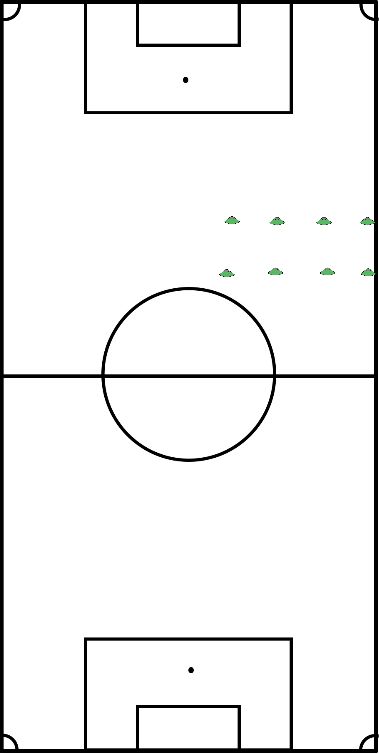
2 Teams compete to see who gets between the hats across the field first.
- 2 teams line up on the side of the field.
- Player 1 stands at one and a half meters with legs apart and facing the queue.
- Player 2 stands in the same position one and a half meters behind player 1.
- Player 3 starts the exercise by slaloming dribbling between the players.
When he has passed the last player, he passes the ball through the spread legs of the other players toward the first in the queue and stands in the same position one and a half meters behind the last player. - When there are no more players in the queue, player 1 starts the slalom and completes it as previously described.
In this way, the team moves forward toward the finish line. Whoever gets there first has won. - By varying the dribble, for example tip-top dribble or reverse dribble, you can make the exercise easier or more difficult.
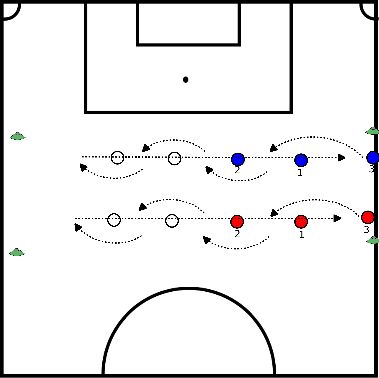
- Warming up with the ball 10 minutes
- 1 Passing
- 2 Bouncing
- 2 Passing
- 1 Dribble
- 1 Passing
- 2 Boucing
- 2 Crossing
- Dribble
- Perform the exercise so often that no one has to sit still.
- Coaching the above mentioned techniques.
- Motivate the players to complete the exercise within the given time.
- Every training session 5 seconds faster.
- A variation or addition is to have players run and pass the ball in diagonal lines.
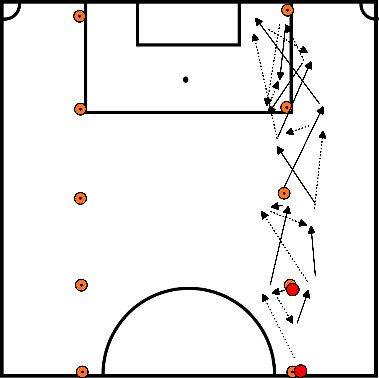
- Player stands behind a set of steps.
- Two feet per "step" in the staircase.
- Watch your posture:
- Walk straight.
- Knees slightly bent.
- Short movements.
- Arms should be active along the body.
- Variation
- Side-Step with two feet per step;
- Zigzagging with one foot in, then two feet on the step, then one foot back in. (different from the first)
- After kicking off, start sprinting and rebound at the pylon on the ball played in.
- Then go back in line.
3 pylons, do the exercises between the middle pawns:
- Knee heels
- Heels buttocks
- Close pass
- Cross pass
- Groin
- Longs
- Kicks
- Run, sprint
- Run, sprint
- Sprinting Sprinting
- The group divides into 2.
- Each group does a warm up exercise to the potty on their right and then walks to the next potty.
- After 5 min
- Rest for 1 minute
- Then increase the pace of the walk (3 min)
- Increase pace even more (3min)
- Maximum sprint (2min)
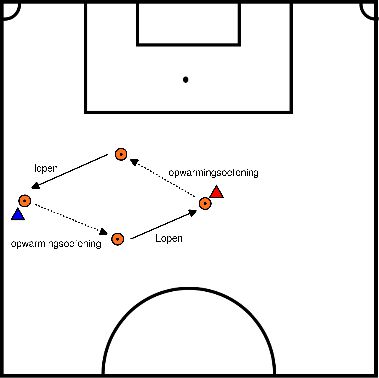
- Each player receives a number beforehand.
- Players move randomly within the indicated space.
- After receiving the ball, it is passed to the next player.
- How many balls can be passed at once?
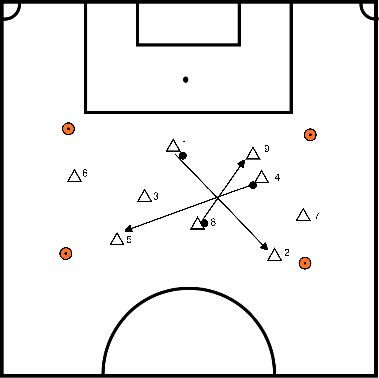
- 2 teams are made.
- In the middle is a pylon (or several).
- Teams transfer the ball to other side first by example:
- Throwing over.
- Kick over.
- Dropkick.
- Heading.
- Ball must be placed on the opposite side of the pile.
- After this the next player can do it.
- When the last ball is returned, the pawn in the middle can be kicked over.
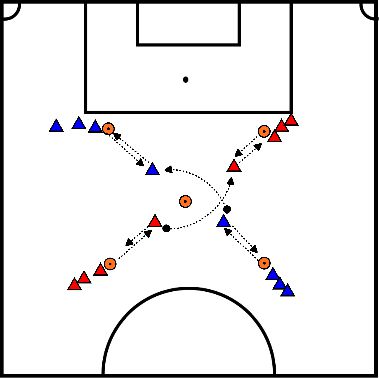
- Two teams are made.
- In the middle stands a pylon (or several).
- Teams first bring the ball over to the other side:
- Throwing over.
- Kick over.
- Dropkick.
- Heading.
- The ball must be placed on the opposite side of the pitch, and the person passing on the ball must also sprint back.
- After this, the next team can play.
- When the last ball is returned, the pawn in the middle can be kicked over.
